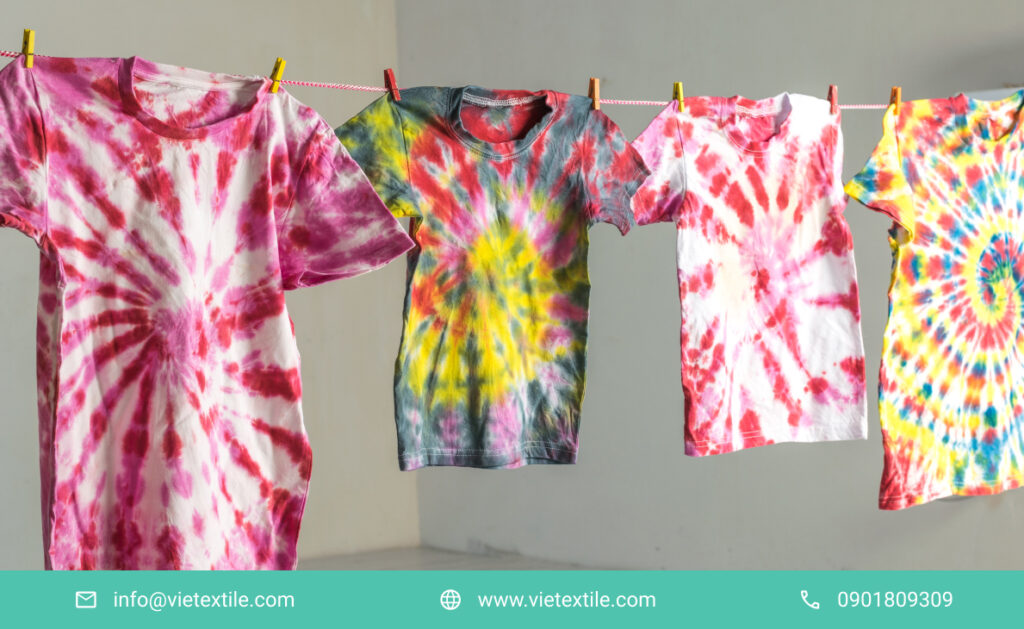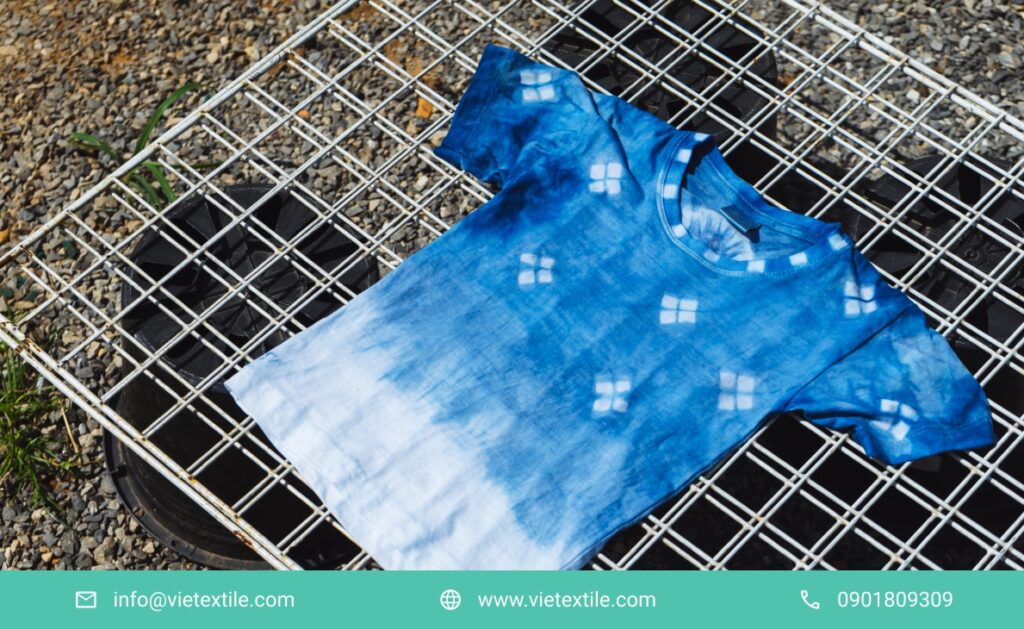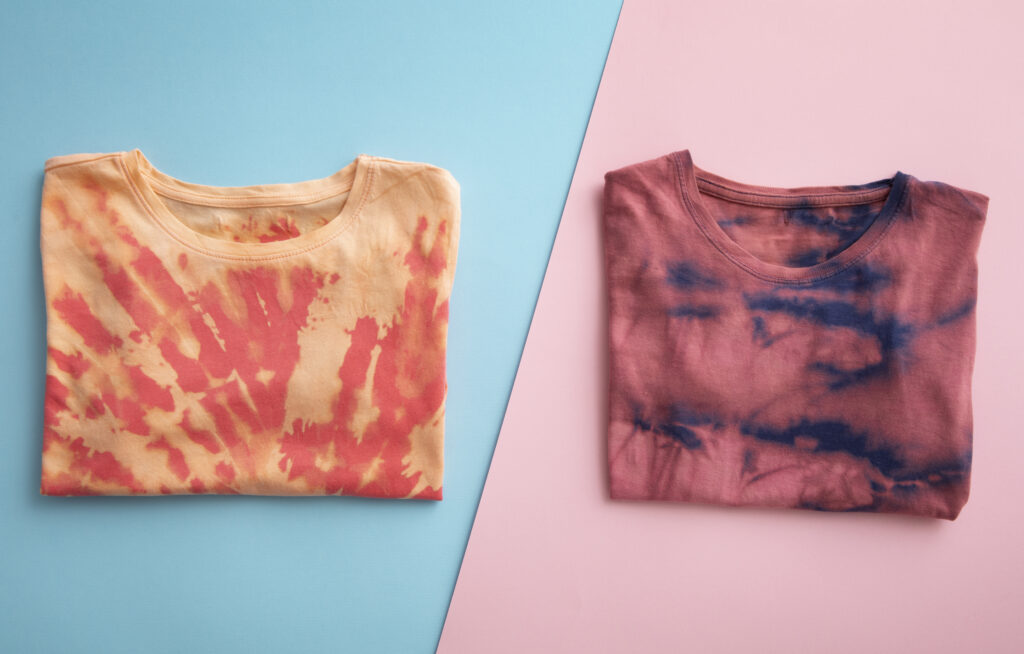T-shirt washing is a fabric treatment process using special techniques to create a fashionable effect. This article will provide a detailed comparison of the 4 most popular washing styles: Acid Wash, Stone Wash, Enzyme Wash, and Bleach Wash, to help you choose the right method for your brand.
1. What is T-Shirt Washing and Why Has It Become Popular?
Nội dung tóm tắt
ToggleHave you ever seen T-shirts with bold, streaky colors or a rugged, vintage style? These are all results of T-shirt washing techniques. T-shirt washing is a process that treats the fabric using chemicals, temperature, and physical techniques to create unique color effects, softness, or a classic, worn-out style that new shirts can’t achieve.
This trend is increasingly popular in Vietnam, especially among the youth and local brands, because it showcases the personality, uniqueness, and creativity of each product.
2. The 4 Most Popular T-Shirt Wash Techniques

2.1. Acid Wash – The Bold, Streaky Effect
Acid wash is a technique that uses acidic chemicals like chlorine or potassium permanganate to create a strong, edgy, and grunge-style streaky effect. However, this method can easily weaken the fabric, so it requires careful consideration and experience to avoid damaging the shirts.
2.2. Stone Wash – Rugged, Vintage Classic
Stone wash creates a worn-out and soft effect using pumice stones. The vintage effect of stone wash is loved for its natural, rugged, and free-spirited look. However, the stones can make the fabric thinner, so care must be taken when processing lightweight fabrics.
2.3. Enzyme Wash – The Premium and Soft Touch
Enzyme wash uses organic enzymes to gently soften the fabric, creating a moderate faded effect suitable for high-end, sustainable fashion products. This technique is chosen by many major brands for its safety on the fabric and its eco-friendly nature.
2.4. Bleach Wash – The Creative Faded Effect
Bleach wash uses a bleaching agent to create faded streaks or lightly bleach specific areas, making it suitable for unique, standout designs. This technique requires careful control to avoid damaging the fabric’s structure and to ensure an even, beautiful fade.
3. A Detailed Comparison of T-Shirt Washing Methods
Although Acid wash, Stone wash, Enzyme wash, and Bleach wash all aim to create unique fashion effects for T-shirts, each technique has its own specific characteristics, benefits, and limitations.
Acid wash stands out with its strong streaky effect, making it suitable for streetwear, grunge, or edgy punk fashion brands. However, acid wash requires high technical control because strong acidic chemicals can damage fabric fibers, making the shirt prone to wear or reducing its lifespan if not done correctly.
In contrast, Stone wash uses pumice stones or similar materials to create an abrasive, naturally faded effect, resulting in a very authentic vintage look. This effect is popular with Vietnamese youth as it creates a rugged, approachable feel. However, if the technique is incorrect or the wrong fabric is chosen (e.g., too thin or low-quality), stone wash can quickly make the shirt thin, or even tear and lose its shape.
Enzyme wash is considered the most premium wash technique, using cellulase enzymes to gently soften the fabric, creating a natural and soft faded effect. This method is chosen by many high-end fashion brands because of its high safety, optimal fabric protection, and eco-friendly nature. The disadvantage of enzyme wash is that it requires a longer processing time and is relatively more expensive than other techniques.
Bleach wash is commonly used to create bright streaky effects or to gently bleach certain fabric areas, creating a contrast on the T-shirt. This technique is suitable for designers who want to create unique patterns, motifs, or gradient faded effects. However, this method can weaken the fabric and requires strict control over chemical dosage to avoid damaging the shirt.
Overall, in terms of cost, Enzyme wash and Stone wash are more expensive due to their complex processes, while Acid wash and Bleach wash are more cost-effective but require a high level of technical skill to avoid risks. In terms of durability, Enzyme wash comes out on top, followed by Stone wash; Acid and Bleach wash can easily reduce the fabric’s lifespan if not well-controlled. Choosing the right wash technique depends on your brand’s style, budget, and product durability requirements. VieTextile is always ready to consult on the optimal solution for each customer.
4. Factors Affecting Quality in T-Shirt Washing
The quality of a T-shirt after washing depends heavily on the materials, the washing process, and the final product inspection.
4.1 Controlling Input Material Quality
- Choose the right T-shirt fabric for each wash style (100% cotton, cotton blend, poly-cotton, cool-touch fabric, spandex, etc.).
- Check the quality of the dyes and colorfastness before washing.
4.2 Standardized Factory Washing Process
- Perform a test wash on a sample before mass production.
- Adjust the amount of chemicals, time, and temperature for each wash style (acid, stone, enzyme, bleach).
4.3 Preventing Common Technical Errors in Washing
- Treat fabric damaged by overly strong chemicals.
- Adjust temperature and time to avoid uneven fading, loss of shape, stretching, or excessive shrinkage.
4.4 Post-Wash Quality Control and Packaging Standards
- Check colorfastness, color uniformity, and shirt shape after washing.
- Implement a proper storage process for washed shirts before delivery to the customer to prevent contamination, mold, or loss of the created effect.
5. Tips for Maintaining Shape and Storing Washed T-Shirts

To maintain the shape and durability of the wash effect, you should hand wash with cold water. Avoid machine washing, especially for acid wash or enzyme wash T-shirts, as the strong spinning can easily stretch the collar or tear the fabric. If you must machine wash, place the shirt in a mesh laundry bag and select the Delicate cycle.
For example: A 100% cotton enzyme wash T-shirt is often soft and thin. Washing it in hot water or wringing it too hard will cause it to lose its shape after a few washes.
When drying, avoid using plastic hangers that clip the shoulders. It’s best to dry the shirt flat on a rack or use a wooden hanger with padded shoulders to help it keep its shape. Dry in a shady, well-ventilated area to prevent fading from harsh sunlight.
Quick Tip: If your shirt stretches slightly after washing, soak it in cold water mixed with 1 tablespoon of white vinegar for about 10 minutes, then drain and dry flat. This helps the fabric shrink back naturally without ruining the wash effect.
When ironing a washed T-shirt, turn it inside out and use a steam iron at a low temperature. Especially with bleach wash or acid wash shirts that have prints, do not iron directly on the fabric to prevent peeling or color bleeding.
Common Errors and How to Fix Them
- Shirt loses its shape or has a stretched collar: Caused by wringing too hard or incorrect hanging. Fix by soaking in cold water with vinegar.
- Lost wash effect or streaky colors: Caused by washing with a strong detergent or drying in harsh sunlight. Switch to hand washing and drying in the shade.
- Moldy shirt: Caused by storing in a damp place. The solution is to dry the shirt completely before storing, or use dehumidifier bags in your closet.
6. Conclusion
Each T-shirt washing technique has its own pros and cons. Acid wash creates a strong streaky effect but requires excellent technical control to avoid fabric damage. Stone wash offers a natural vintage look, but it’s more expensive and can wear down the fabric if the process is not up to standard. Enzyme wash makes the shirt soft, colorfast, and keeps its shape well, making it suitable for premium products, but it requires a higher budget. Bleach wash is flexible and great for creating creative faded effects but needs chemical control to ensure fabric safety.
Choosing the right washing method depends on your design goals, fabric material, and production budget. If you need a professional, consistent, and cost-effective solution, contact VieTextile immediately for a detailed consultation and the best quote for your T-shirt washing service!
Frequently Asked Questions (FAQs)
- Does T-shirt washing damage the fabric? No, if done with the correct technique. Enzyme wash helps protect the fabric fibers, while acid wash and bleach wash need to be well-controlled to avoid weakening the fabric.
- Is acid wash or stone wash more expensive? Stone wash is more expensive due to the use of pumice stones and a more complex process. Acid wash is more cost-effective but requires high technical skill.
- Does enzyme wash help a shirt keep its shape? Yes. Enzyme wash makes the fabric soft and helps the shirt maintain its shape well, especially with 100% cotton.
- Does bleach wash create a uniform or localized fade? It depends on the technique. You can create a full-body fade or a localized one as desired if you control the chemical dosage and time well.
- Should I wash T-shirts myself or hire a professional service? Self-washing is suitable for simple DIY. A professional service like VieTextile ensures quality, consistency, and safety for large-scale production.










